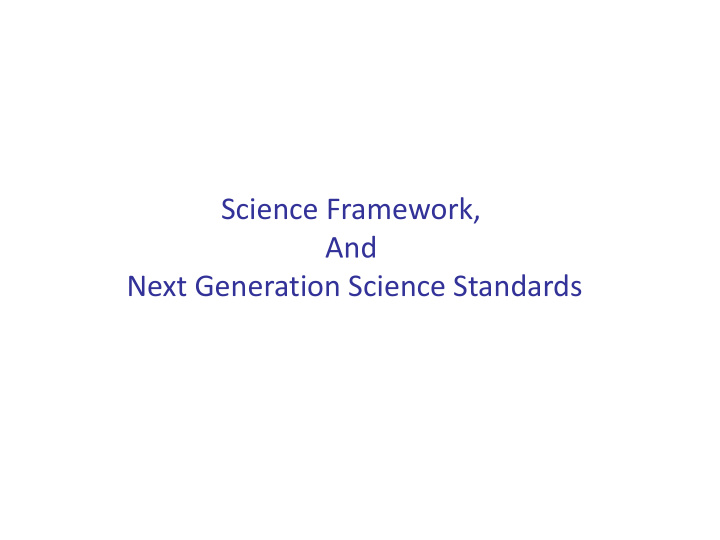



Science Framework, And Next Generation Science Standards
Context • Education is US is a controlled at the state and local level. • Common Core Math and Language Arts -- 47+ states choosing common standards Next Generation Science Standards • Stage 1 NRC Framework – July 2011 • Stage 2 Achieve and 26 State teams Next Gen Standards – released April 2013 so far 5 states have adopted, CA likely will
Assessments Curricula Framework Standards Instruction Teacher Preparation and development
A Framework for K-12 Science Education Product of National Research Council (Board on Science Education) study 9 scientists (all NAS members, 2 Nobel ) 9 education experts (research and practice) www.nap.edu free to download
Framework task • What does research on learning tell us about how to teach science most effectively? (scientific science education) • What are the most important ideas in science for k-12 students? • Things every student needs to know something about or be able to do Science for life and citizenship, not just for those who will becomes scientists and engineers.
Three Dimensions • Scientific and engineering practices • Crosscutting concepts • Disciplinary core ideas Demands instruction that is 3 dimensional • NGSS – standards as performance tasks that involve all 3
Goals of the Framework • Coherent investigation and development of core ideas across multiple years of school • Blending of science and engineering practices with core ideas and crosscutting concepts NGSSS closely based on Framework
Scientific and Engineering Practices 1. Asking questions and 5. Using mathematics and defining problems computational thinking 2. Developing and using 6. Developing explanations models and designing solutions 3. Planning and carrying out 7. Engaging in argument from investigations evidence 4. Analyzing and interpreting 8. Obtaining, evaluating, and data communicating information
*Crosscutting Concepts 1. Patterns 2. Cause and effect: mechanism and explanation 3. Scale, proportion and quantity 4. Systems and system models 5. Energy and matter: flows, cycles and conservation 6. Structure and function 7. Stability and change *All require models!
Next Generation Science
NGSS task • Create a multi-state network • Develop standards based on framework • Standards as performance expectations • Blending practices, cross-cutting concepts and disciplinary core ideas (dci)
Lead State Partners
Multiple rounds of review • 7 times for state teams • AAPT, NSTA etc invited to review parts • 2 times for public • Real changes made based on input
Example Middle School – Matter and its Interactions 1. Performance expectations 2. Framework basis 3. Connections
Example:MS MAtter
Less • Detailed vocabulary • Disconnected lessons • Rote problems • Teacher lecture
More • Student discourse and argumentation • Student developed MODELS • Open ended problem solving
IQST Assessment: Modeling Smell Your teacher opened a jar that contained a substance that had an odor. Imagine you had a very powerful microscope that allowed to see the odor up really, really close. What would you see? • Lesson 15: student models – 75% of students create a particle model, 25% a mixed model – 68% of students include odor particles that are moving in straight lines until they collide into each other; 32% include both odor and air
Models make thinking visible and explicit • What system is being studied? • What (artificial) boundary delimits the system under study? • What are its components or subsystems? • How do the components interact? • What (matter or energy) flows into or out of system? • What forces act across boundary?
Model building and observation As in art, so in science, the attempt to represent drives to more careful observation of what is being represented Decisions must be made: what to foreground, what to leave out how to revise…
What comes next • State decisions on adoption • New Assessments?? • New or revised curriculum materials?? • Professional development??
Standards are not curriculum • Knowledge in pieces, even when given as performance expectations • Curriculum must be designed to be coherent, sequenced and connected
Implementation • Requires multiple years of work • Colleges and Universities have a role to play If teachers never meet science practices in their own science courses how can they teach students to engage in them?
Recommend
More recommend